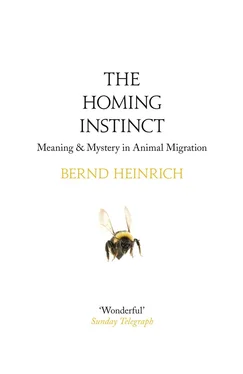1 ...8 9 10 12 13 14 ...19 Because these caterpillars are protected from predators in the summer homes they build and by the spines they wear, because they mature early enough in the summer for the pupae to avoid the cold of winter (by early emergence of the moth), and because the eggs and young larvae are immune to freezing because of the antifreeze they contain, “everything” in the life of the tent caterpillar moth may be found within a few meters. The adults that emerge in late June are not far from the apple or cherry trees where the parent left her eggs, and their life cycle can be completed without their having to go far from home, unlike some other insects which traverse a continent to be able to satisfy all their needs.
Monarchs.Of all the insects, the travels of the monarch butterfly, Danaus plexippus, are perhaps most famously spectacular in both scale and scope. Dr. Lincoln P. Brower of the University of Florida in Gainesville (now at Greenbriar College), who has studied this butterfly and its migration for over forty years, records the rich history of the emergence of our knowledge of monarch migrations. Early naturalists saw “immense swarms” in the prairie states where the caterpillars fed on the leaves of the many native species of milkweed ( Asclepias ) and the adults fed on the nectar of their flowers. Monarchs declined when later industrial agriculture destroyed many of their food plants, but in the nineteenth century they resurged in the East due to land clearing and the spread mainly of one milkweed, A. syriaca. Millions of them were seen passing for hours, even in Boston. This was a phenomenon that is hard to imagine now and it ignited much interest then. Charles Valentine Riley, the entomologist who first hypothesized that these butterflies engaged in a birdlike migration, cites people seeing them in the fall in swarms that extended for kilometers and obscured the sun, “blurring day into night.” Huge lines of them passing Boston in 1880 were described as “almost beyond belief.” Now, with reforestation, plowing, and then the use of Roundup and other weed killers that eliminated their food plants in agricultural fields, the monarch is but a shadow of what it was. In the past several years in the East, it seems to have almost disappeared. For the first time, I saw not a single one in late summer of 2013. But our knowledge of the scope of the monarch migration has blossomed.
Monarchs migrate on their own power for thousands of kilometers, and, unlike many other insect migrants, the population (though not the individuals) has a regular two -way migration, although as with the other insect migrants, the individuals that come back are not the same ones that left.
Unlike most of the other North American butterflies and moths, which overwinter in New England as eggs, larvae, pupae, or adults, monarchs cannot survive there through the winter in any stage. The population that normally now graces fields all along eastern North America overwinters at around three thousand meters’ elevation in dense fir groves on the southwest slopes of volcanic mountains thousands of kilometers to the southwest, near Mexico City. The monarchs find shelter in those fir stands from rain, hail, and occasional snow. It is not cold enough for the butterflies to freeze there, but it is cool enough for them to conserve the energy resources that they have accumulated on their way south.

The monarch butterfly adult, caterpillar, and chrysalis
In the summer, the monarchs fly in what look like random zigzag patterns over the New England fields as they stop here and there to sip nectar. Occasionally you see a mated pair, the female doing the work of flying, the male dangling passively with folded wings while attached by his genitals. After the prolonged mating (and/or technically “mate guarding,” since it prevents mating by other males), the female glues her delicately patterned green eggs with gold markings, one at a time, to the undersides of milkweed plants. In a few days, the flashy yellow-black-white larvae hatch and start chomping. After about fifteen days (depending on the temperature), the caterpillars have increased their weight to 1.5 grams (2,780 times the hatchling weight). The caterpillar attaches itself to a support such as the underside of a leaf by a clasping organ at the hind end of its abdomen to hang upside down. It will then molt into the bright green pupa (chrysalis) with the shiny golden spots that is surely familiar to almost all school kids. In a few days, the chrysalis starts to turn dark, and the outlines of the orange-patterned wings are visible through the now-transparent cuticle. When the chrysalis splits, along a predetermined line of weakness in the back, the limp adult slips out and expands its wings, and in two or three hours hormones will have instigated a biochemical process that hardens its body armor and stiffens its wings. The butterfly is ready to fly. Where will its wings take it?
Thanks to the monarch studies initiated in 1935 by Dr. Fred A. Urquhart and his wife, Norah Urquhart, from the Zoology Department of the University of Toronto and continued to the present day with the input and cooperation of thousands of amateur volunteers, there is now an amazing story to tell. The Urquharts noted in the late 1930s that the monarchs they saw in late May and early June in Canada had tattered wings, and they knew that this species would not and could not overwinter in Canada, so they suspected that they may have come a very long way. Monarchs fly in a southwesterly direction in the fall, but nobody had a clue where they ended up. To get some idea of the butterflies’ movements, these researchers in 1937 began gluing paper tags onto monarch wings with this message: “Please send to Zoology University Toronto Canada.” Monarchs weigh almost half a gram and the wing tags only 0.01 gram, so the tags were not likely to hamper the animals’ movements. Similar tags, used today, have pressure-adhesive backing and can be folded in half and glued over the leading edge of the forewing (after the scales are removed).
The idea from the inception of the monarch-marking studies was to try to find out if the butterflies migrated — an idea that at the time, as Urquhart noted, “was considered quite impossible.” But the question of where the butterflies might be going to and coming from grabbed the imagination, and anyone seeing a tagged butterfly would be sure to try to catch it. Sure enough, tags were returned over decades that suggested a migratory pattern. Individual tags were returned from huge distances, up to 1,288 kilometers. One monarch that was tagged in Ontario in 1957 was recovered eighteen days later in Atlanta, Georgia, 1,184 air kilometers distant. Clearly, when the butterflies left Canada in the fall, they headed south.
Still, nobody knew what happened to the mass of butterflies. Then, in January 1975, Cathy and Ken Brugger of Mexico City found them — a dazzling, shimmering, orange display of an estimated 22.5 million monarch butterflies on one 2.2-hectare site (which turned out to be only one of ultimately thirteen overwintering sites in the mountains of Mexico). The millions of monarchs were festooned in the trees in the mountains of Michoacán near Mexico City. The Urquharts excitedly traveled to see the site and on January 18, 1976, listened to “the sound of the fluttering of thousands of wings [that was] like that of a distant waterfall.” As they stood awestruck by this dazzling display, a pine branch broke off from the sheer weight of butterflies attached to it, and it crashed to the ground right in front of them. Fred Urquhart had been posing for a National Geographic photographer surrounded by these just-fallen butterflies when, incredibly, he saw a tagged one among them. When he traced its origin, he learned that it had been tagged on September 6, 1975, by Jim Gilbert, from Chaska, Minnesota. Urquhart, who had encountered countless tagged butterflies in his career, said it was “the most exciting one I have ever experienced.”
Читать дальше













